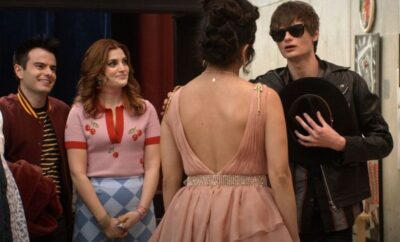Movie Reviews
Queercore: How to Punk a Revolution
By: Taylor Gates
This year alone there have been several outstanding documentaries highlighting underappreciated people and groups that are heavily influencing various aspects of queer culture. There is Every Act of Life, which examines the life of Tony-winning gay playwright Terrence McNally and his impact on the theatre community in New York City. There is also the fantastic Gospel of Eureka that centers on a tiny, diverse town in Arkansas at the center of the transgender bathroom bill. Plus, Game Girls follows two queer women facing extreme poverty on Los Angeles’ Skid Row.
Queercore: How to Punk a Revolution follows this tradition, its setting the queer punk scene in the 80s and 90s, mainly homing in on Toronto and San Francisco. The documentary explores and celebrates a moment in history, showing how a small group of people creating queer, hypersexualized art and music started a movement that went onto span far beyond the scope of their own bubbles and reach fellow queer communities all over the world.
In order to capture the unique tone of the gay punk rock scene (aptly called “Homocore” or later “Queercore”), filmmaker Yony Leyser employs a collage of mediums and includes a variety of sources. There is a plethora of archived concert footage of different bands like Sonic Youth, Nervous Gender and Tribe 8 as well as clips from No Skin Off My Ass, an experimental dramedy by filmmaker Bruce LaBruce. In addition, there are photos of popular zines in circulation at the time like J.D.s and Homocore, vivid animation sequences by Aimee Goguen and recent interviews conducted with Queercore’s most iconic and influential figures like GB Jones and Beth Ditto. The blend works well, keeping the vibe fresh and fun.
People of different ages and backgrounds are likely to have vastly different experiences watching this film. Those who grew up during the 80s and 90s and have firsthand accounts of being immersed in this culture will probably enjoy the well-made trip down memory lane. As for the younger demographic, it has the potential to be an educational experience about an important piece of history for their community. However, it’s not always incredibly accessible and might be a turn off for some.
For instance, the Queercore revolution makes a point to avoid political advocacy in favor of cultural activism. In this day and age, there is a large importance placed on political involvement; after all, it’s practically unavoidable. This mindset of being anti-peaceful protest, pro-shock value and not engaging in political reform for the sake of art seems rather outdated and frankly a bit tone deaf.
The fight to be included in mainstream culture is currently the prominent attitude–a perspective that Queercore wholeheartedly disdains. For example, movies like Love, Simon and The Miseducation of Cameron Post are popular at the box office and Troye Sivan and Hayley Kiyoko have millions of followers on social media, singing songs about same-sex love and relationships. So much has changed in the past several years and although we have a long way to go, to write off these accomplishments as products of assimilation or accuse participating artists of not going down the correct path would be ignorant.
Though the film tries to reiterate that Queercore is beneficial to everyone, it’s ultimately not especially convincing. Some of the interviewees gripe that the gay community “has too many rules now,” which feels dangerous and counterproductive. The rejection of all popular culture feels limiting, insinuating that you’re not a real member of the LGBTQ+ community unless you’re fully dedicated to isolating yourself–an unhealthy way to go. One interviewee even chimes in that they find “corporate hip-hop and Madonna counter-revolutionary.” The comment comes across as condescending instead of informative and the pretentious tone permeates much of the documentary, leaving me with a bit of a sour taste.
Obviously, this revolution took place before the #MeToo movement and it shows. One problematic moment happens when an interviewee recounts how he used to lure straight men into his home, get them drunk, tell them to undress and then take photos of them for his films. Sure, this was a different time, but there’s no critique or apology in retrospect. Instead, it’s practically glorified, said with a laugh. “It wasn’t just acceptable,” the film seems to say, “it was necessary.”
In spite of some of its downfalls, there are poignant and powerful moments scattered throughout the film. It’s at its best when it focuses on the grassroots aspects of the movement and how it branched off to inspire the closely-related Riot Grrrl revolution. One particularly interesting strategy the movement’s pioneers would utilize was stretching the truth when it came to stats. Though they were scarcely given mainstream media attention, when they did they would say that the Queercore movement was absolutely booming in their city and all over the world. This would then inspire kids who read their articles to form their own Queercore groups within their own neighborhoods. Though this was before the internet, they would distribute self-published zines that could double as a newsletter of sorts – no longer did you need television access or a connection with a major publisher. It’s little details like that that are truly inspiring.
The emergence and liberation of women in the punk rock scene, widely known as Riot Grrrl, was rooted in Queercore as well. At this time, female punk band members were already few and far between and the ones who did have a platform refused to call themselves feminists. Fed up, groups like Bikini Kill and Gossip attempted to lure women from the to the pit itself, making the space safer and appealing to more than just traditionally masculine men. Hearing icons like Peaches and Kim Gordon share their own stories and goals feels relevant and important.
There’s no doubt that Queercore: How to Punk a Revolution got the details right, painting a textured and rich yet cohesive and succinct snapshot of the scene in all its grungy, blowjob-ridden glory. But while it has no trouble capturing the past, it disappointedly doesn’t try and connect with the present day despite many current interviews.
“Find your people,” says Gossip singer Beth Ditto. “Stick to your people.” Unfortunately, the documentary sends the message that if your people aren’t those depicted in the film, you’re probably nothing more than a sell-out. The whole point of Queercore is to dare to be authentic, finding an inclusive community when you’re rejected by society. It’s just too bad it feels so exclusive most of the time.





1 Comment
You must be logged in to post a comment Login